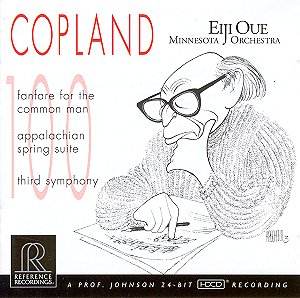AARON COPLAND (1900-1990)
Fanfare for the Common Man (1943) 3.32
Appalachian Spring suite (1944) 25.09
Symphony No. 3 (1946) 43.33
 Minnesota Orchestra/Eiji Oue
Minnesota Orchestra/Eiji Oue
rec 25-26 March 2000, Orchestra Hall, Minneapolis
 REFERENCE RECORDINGS
RR-93CD
[70.04]
REFERENCE RECORDINGS
RR-93CD
[70.04]
Crotchet
Amazon
US

These three works of the 1940s sing of conflict, poetry and a thrilling new
confidence.
The fanfare needs no introduction. It is one of the 20th century's icons
as much as Barber's Adagio and just as affecting. The Appalachian
Spring suite touches off so many melodic streams: purity, naively probing,
dancing (Holst's Jupiter), rangy, bucolic. It is given by Oue as fine
a performance as any although in a version for full orchestra rather than
the original chamber ensemble. Strange how, for the first time, I noticed
echoes of the naive Prokofiev in this work. I think particularly of Winter
Bonfires. There are edit blips at 3.21 and 10.37; most unusual from Reference
Recordings. but nothing to disturb the mood. Has anyone ever noted the similarity
to the 'play' music from Bliss's Things to Come and the woodwind dance
at 10.20?
As part of the war effort Copland contributed a score for the film North
Star. This propaganda effort sang the heroic virtues of a group of partisans
in Russia fighting the Nazi invader. This was at a time (too easily forgotten)
when US foreign policy endorsed the Soviet government as an ally. The music
is accessible, uses full orchestra and choir. Its street corner and folk-heroics
are now too easily sneered at. Its populist language, though treading the
line between accessibility and banality, is instantly attractive. A complete
recording is imperative (are you listening Varese-Sarabande or Chandos?)
but if it must be a suite why not couple it with the contemporaneous and
equally unknown scores Prokofiev wrote in 1942 for the Soviet partisan films.
The money earned from North Star made possible the writing of the
Third Symphony; that and a commission by the Koussevitsky Foundation. The
symphony is serious and a contrast with its predecessors, the first (1928)
being an adaptation of a piece for organ and orchestra and the second, the
so-called Short Symphony, being for chamber forces. This was a symphony
with warlike ambition influenced by Piston, Diamond, Schuman and Roy Harris
whose fifth symphony is dedicated to the Soviet People.
The first movement is questioning, feeling its way, but with glimpses of
trudging epic confidence and fanfare-like presentiments. The second is a
Prokofievan, triumphalist, lit by sickle-sharp fluttering banners. So fast
is the full pelt that once or twice I wondered about the articulation of
the Minnesota wind players. This movement strongly touches base with the
Soviet style of Shostakovich 5 and 7, Festive Overture, Panufnik's
Heroic Overture and Schuman 3.
The long and sensitive andantino shades without pause into a pp
flute statement of the Fanfare for the Common Man. The orchestra takes
up the fanfare in all its stalking majesty - surveying the far horizons of
a new age with a brooding confidence borne of anguish and bereavement. Hymn-like
and epic the closing pages are delivered with the affirmative swing and impact
of a sledge-hammer.
I would not like to choose between this version and the competing accounts
by Bernstein and Copland. Reference have a far superior recording quality
and tends towards subtlety and refinement rather than the stridency of Bernstein.
If we now think, amid all this heroic warmth, of film music of a later era
(John Williams in Saving Private Ryan and the various Star Trek
movies) we catch some echo of what might have been if Hollywood had not
turned its back on such a towering talent. Ultimately saturated by such language
Copland turned sideways from it and retreated into a far more filtered, private
and less accessible idiom. Ironically the later works would have earned him
condemnation had they been written in the USSR.
Eiji Oue (a Bernstein protégé) and the Minnesotans adopt a
reserved and subtle approach in all these works, avoiding the blatancy of
other interpretations including Bernstein's. For the same reason you may
find that this is a disc that yields rewards after repeated listenings. My
first impressions were low key but the approach grew on me as I listened
again. The recording is big and bold but to access these qualities you need
a high volume setting. The soundpicture is one of a great concert hall with
the listener sat about twenty rows back in the auditorium.
The music sings Copland, the people's man, the man whose communist convictions
earned him Hollywood's rejection and one of whose early choral works celebrated
the Revolution with a flag-waving piece of street rebellion: not at all an
Establishment voice. Worth remembering in this centenary year. And when will
it be more timely to record the complete score for The North Star.
A brilliant Hirschfeld cartoon adorns the booklet and the satisfyingly full
notes are by Howard Pollack whose recent book is 'Aaron Copland: The Life
and Work of an Uncommon Man' (New York, 1999).
One of the central recording events in the centenary year.
Rob Barnett

